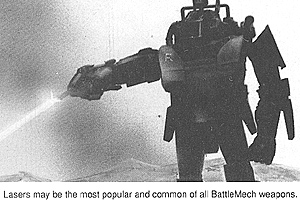 Lasers may be the most popular and common of all BattleMech weapons. Their single greatest advantage over other weapons systems is the fact that they are powered off of the 'Mech's power plant and, therefore, will never run out of ammunition. Too, they are not as heavy and do not build up as much heat when they fire as particle cannons.
Lasers may be the most popular and common of all BattleMech weapons. Their single greatest advantage over other weapons systems is the fact that they are powered off of the 'Mech's power plant and, therefore, will never run out of ammunition. Too, they are not as heavy and do not build up as much heat when they fire as particle cannons.
Lasers are energy weapons capable of delivering large amounts of energy to the target through a monochromatic or "lased" beam of light. Most modern battlefield lasers are pulse lasers, meaning they release that energy in a short, intense burst.
Laser energy is measured in megajoules (millions of joules), with onejoule equivalent to 1 watt of energy delivered in 1 second. Battle Mech- m ou nted lasers characteristically have an output of between .8 and 5 megajoules of energy in a short, intense pulse lasting less than one one-hundredth of a second. By comparison, the explosion of 1 kilogram of TNT releases approximately 5 megajoules of energy.
Beam lasers exist which fire at much lower energy levels but can "play" the beam against the target for periods as long as several seconds. There are advantages and disadvantages to each system, of course. Beam lasers do not require as much power, last longer, and do not build up as much heat as pulse lasers, but the beam must be held against a single spot on an enemy target long enough for the beam to burn through the target's armor. In modern combat, against highly mobile 'Mechs, this luxury is rarely possible. Pulse lasers are more prone to breakdown and overheating than beam lasers, and a common battlefield problem is the partial or total meltdown of the system's pulse chamber reflectors, cyclic coils, or cooling units. However, firing a pulse laser is much like firing a cannon. The weapon's destructive power hits the target in a small, violent package-all of it applied against a single small portion of the armor.
There is no theoretical limit to a laser's range. Under battlefield conditions, however, laser ranges are limited by smoke, dust, and anti-laser aerosols. So long as the target is not obscured by weather, smoke, or other adverse conditions, however, it is still possible to hit a target as far away as a planet's horizon. At such extreme ranges, the target's movement becomes the chief handicap in laser targeting. Beam attenuation-the tendency for the destructive beam to spread slightly and lose some of its power due to dust particles and the refractive qualities of the atmosphere-lessens the punch of a laser at extreme ranges as well.
Battlefield lasers are divided into three broad categories, based on their power output. These are:
Small Lasers: These range in power output from .8 to 1.5 megajoules. Because of the thickness of modern composite armor, the effective range of small lasers is limited to 90 meters. Because of their restricted effective range, they are the least common of 'Mech laser weapons and are found only as secondary or back-up armament for such 'Mechs as the Warhammer and the UrbanMech.
Medium Lasers: Medium lasers range in power from 1.5 megajoules to 3 megajoules and have an effective range of up to than 300 meters. More powerful and longerranged than small lasers but without the heating problems of large lasers, medium lasers are the most popular and common of BattleMech laser weaponry. Medium lasers are frequently the main weapon of light 'Mechs such as the Locust and Stinger and are found as secondary weapon systems in heavier 'Mechs such as the Marauder and Archer.
Large Lasers: The heaviest laser weaponry is mounted only on 'Mechs designed around the heavy and cumbersome cooling and power feed gear of these weapons. They range in power from 3 to 5 megajoules and nearly match PPCs in destructive potential-and in heat build-up for the firing 'Mech. Large lasers are mounted as primary weapons in'Mechs such as the Phoenix Hawk and Thunderbolt They have an effective range of nearly half a kilometer.
BattleMech Weapons Crisis of Range and Accuracy
-
Introduction
Lasers: The Light Fantastic
Particle Projector Cannon: Lightning Made to Order
Missiles: Unguided Messengers of Death
Autocannon: Machine Guns with a Kick
Machine Gun: Ancient Killer on the Battlefield
Flamer: Anyone Got a Light?
Limited Ranges and the Collapse of Civilization
Back to BattleTechnology 3 Table of Contents
Back to BattleTechnology List of Issues
Back to MagWeb Magazine List
© Copyright 1988 by Pacific Rim Publishing.
This article appears in MagWeb (Magazine Web) on the Internet World Wide Web.
Other military history articles and gaming articles are available at http://www.magweb.com